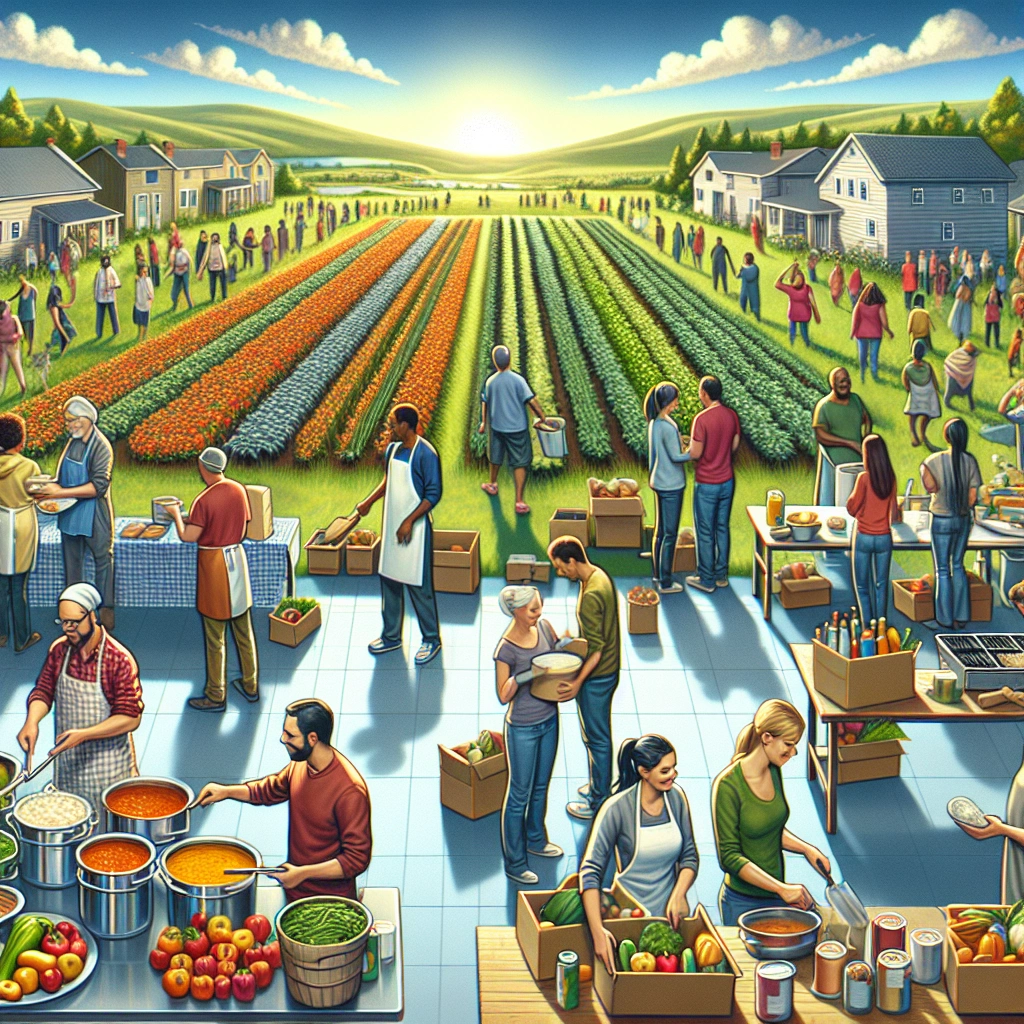

Food insecurity in America refers to the limited or uncertain access to nutritious food, which affects approximately 10% of the U. S. population. While it may not always cause hunger, it can lead to serious health consequences and difficult decisions for individuals and families.
Communities in America are impacted by food insecurity through increased risk for chronic health conditions, such as obesity, heart disease, and diabetes. Additionally, food insecurity can make it more difficult for children to learn and grow, leading to long-term consequences for their well-being.
The prevalence of food insecurity in the United States also leads to difficult decisions for households, such as choosing between food and other necessities like rent, bills, and transportation. This underscores the pervasive and multifaceted impact of food insecurity on communities across America.
Check out this Youtube video: Gain a deeper understanding of the impact of food insecurity on communities in America by watching “America’s Food Insecurity | Inside America with Ghida Fakhry.”
The Scope of Food Insecurity in America
Statistics on the prevalence of food insecurity in the United States
| Statistic | Data |
|---|---|
| Food-Insecure Households | 17.0 million in 2022 |
| Very Low Food Security | 6.8 million households |
| Total Population Affected | 44.2 million people in 2022 |
Factors contributing to food insecurity in communities
- Poverty as the Main Cause: The primary factor contributing to food insecurity in American communities is poverty. Low wages, adverse economic conditions, and limited access to healthy foods are deeply entrenched issues associated with poverty.
- Racial Disparities: There are notable disparities in food insecurity prevalence, with Hispanic households experiencing a 17.2% prevalence compared to the national average of 10.5%. Neighborhood conditions, physical access to food, and transportation barriers contribute to these disparities.
- Interconnected Root Causes: Food insecurity is challenging to address due to deeply intertwined root causes such as poverty, unemployment, inconsistent access to healthy food, and residential segregation. These factors create instability and unpredictability for households, adding stress to an already vulnerable situation.
The scope of food insecurity in America is significant, affecting millions of households and individuals. The prevalence of food insecurity is closely tied to poverty, racial disparities, and interconnected economic root causes.
Addressing these factors is crucial to combatting food insecurity and ensuring the well-being of communities across the United States.
Economic Impact of Food Insecurity
Effect of food insecurity on the local economy
Food insecurity has a significant impact on the local economy, leading to decreased productivity and increased healthcare costs due to malnutrition-related illnesses. Additionally, it results in reduced consumer spending in local businesses, as individuals allocate limited resources to essential needs like food rather than discretionary spending.
Cost of food insecurity to local businesses and government assistance programs
The cost of food insecurity to local businesses is substantial, as it lowers employee productivity and increases healthcare expenses. Moreover, government assistance programs bear the financial burden of addressing food insecurity, with federal spending on food and nutrition assistance totaling $183.0 billion in fiscal year 2022. This includes programs such as SNAP, WIC, and NSLP, reflecting the massive impact of food insecurity on public expenditure.
Health Consequences of Food Insecurity
Relationship between food insecurity and health issues
Food insecurity in America has a direct and significant impact on health, leading to a higher prevalence of chronic health conditions. Individuals and families facing food insecurity are more likely to experience health issues such as diabetes, obesity, heart disease, mental health disorders, and other chronic diseases.
This correlation stems from the lack of access to affordable, nutritious food, which often results in inadequate nutrient intake and contributes to the development of these health conditions.
Impact on children, elderly, and vulnerable populations in communities
The impact of food insecurity extends beyond individual health, affecting vulnerable populations within communities, including children and the elderly. Studies have revealed that food insecurity contributes to lower nutrient intakes, cognitive problems, and increased risks of birth defects, anemia, and chronic diseases among these groups.
Additionally, food-insecure households, particularly those with children and low-income individuals, are disproportionately affected, exacerbating the challenges faced by these already vulnerable populations.
Food Insecurity and Academic Performance
Influence of food insecurity on academic achievement
Food insecurity has a profound impact on children’s academic achievement, as hunger and malnutrition can hinder cognitive function, memory retention, and concentration. This leads to poor performance in school, affecting their ability to learn and excel academically.
Additionally, the stress and anxiety caused by food insecurity can further impede a student’s academic success, creating barriers to their overall educational development.
Educational implications of food insecurity in communities
The educational implications of food insecurity in communities are far-reaching, resulting in lower graduation rates, decreased academic motivation, and higher rates of absenteeism. Students from food-insecure households are more likely to experience challenges in meeting educational milestones, disrupting their overall academic trajectory.
As a result, educational institutions must recognize the impact of food insecurity and take on responsibility to ensure students have access to nutritious meals, creating a conducive learning environment for all.
| Categories | Impacts |
|---|---|
| Cognitive function | Hindered by hunger and malnutrition, impacting learning abilities |
| Academic motivation | Decreased due to stress and anxiety from food insecurity |
| Graduation rates | Lower for students from food-insecure households |
| Absenteeism | Higher among students experiencing food insecurity |
Addressing food insecurity in communities is crucial for the academic success and overall well-being of students. By recognizing and addressing the educational implications of food insecurity, schools and academic institutions can take proactive measures to ensure that all students have the support they need to thrive.
Food Insecurity and Mental Health
Psychological impact of not having access to adequate food
The psychological impact of not having access to adequate food is substantial. Individuals experiencing food insecurity often face heightened levels of stress and anxiety, stemming from the uncertainty and unpredictability surrounding their next meal.
This chronic stress can have profound effects on mental well-being, leading to an increased risk of depression and anxiety disorders in affected communities.
How food insecurity affects mental well-being in communities
Food insecurity profoundly affects the mental well-being of communities across America. It creates an atmosphere of persistent worry and unease, contributing to elevated levels of anxiety and depression.
Additionally, the psychological toll of not having reliable access to sufficient food can result in decreased cognitive function and impaired emotional regulation, affecting the overall mental health of individuals within these communities.
Food Insecurity in Urban Communities
Specific challenges and impact of food insecurity in urban areas
In urban communities, food insecurity presents specific challenges such as limited access to fresh and affordable produce, leading to an increased reliance on processed and unhealthy food options. This lack of access contributes to higher rates of diet-related health issues, such as obesity and diabetes, impacting the overall well-being of urban residents.
Unique factors affecting food access in densely populated cities
Unique factors affecting food access in densely populated cities include limited availability of grocery stores in certain neighborhoods, commonly known as food deserts. These areas lack access to fresh and nutritious food, making it difficult for residents to maintain a healthy diet.
Additionally, transportation challenges and high food prices further exacerbate the issue, disproportionately impacting low-income urban communities.
| Challenges | Impact of Food Insecurity in Urban Areas |
|---|---|
| Limited access to fresh produce | Higher rates of diet-related health issues |
| Higher reliance on processed food | Overall impact on the well-being of urban residents |
| Limited availability of grocery stores | Impact on low-income urban communities |
| Transportation challenges | Disproportionate impact on food access |
| High food prices | Exacerbation of food insecurity |
By addressing these challenges and understanding the unique factors affecting food access in densely populated cities, we can implement targeted solutions to improve food security and ensure that all urban communities have access to nutritious and affordable food options.
Food Insecurity in Rural Communities
Challenges faced by rural communities in addressing food insecurity
Rural communities face significant challenges in addressing food insecurity. One of the major challenges is the lack of access to healthy and affordable food options.
Many rural areas are classified as food deserts, with limited availability of fresh and affordable foods. Additionally, factors such as low wages, lack of transportation, and limited job opportunities further exacerbate the struggle to afford nutritious meals.
These challenges create a barrier for rural residents in accessing the essential food items needed for a healthy and balanced diet, leading to higher vulnerability to food insecurity.
Impact on agricultural communities and farming families
The impact of food insecurity extends to agricultural communities and farming families. Despite being integral to the local economy, some farming communities face food insecurity due to inadequate access to nutritious food.
This paradox is particularly concerning as these communities are directly involved in food production. Moreover, food insecurity can lead to adverse health outcomes for farming families, affecting their overall well-being and productivity.
The intertwining of food insecurity with agricultural practices highlights the complex and multi-faceted nature of this issue, necessitating concerted efforts to address the challenges faced by rural communities.
Food Deserts and Access to Nutritious Food
Definition and explanation of food deserts
Food deserts are areas where residents lack access to fresh, healthy, and affordable food options, typically due to the absence of grocery stores and supermarkets within a convenient distance. These areas often have an overabundance of less healthful food choices, contributing to higher rates of diet-related conditions like obesity, diabetes, and cardiovascular disease.
Food deserts are prevalent in lower-income, inner-city, and rural communities, exacerbating health disparities among residents.
Lack of access to fresh and healthy food options in certain areas
The lack of access to nutritious food in these areas results in significant public health effects, including increased consumption of less healthful food items and limited availability of essential nutrients. Residents are at a higher risk of developing chronic diseases due to poor diet.
Community-based solutions such as local markets, community gardens, and surplus food initiatives have been proposed to address this issue and improve access to healthy foods in food deserts. Additionally, promoting farmers’ markets and offering affordable, nutrient-rich options can play a vital role in mitigating the impact of food deserts on communities.
| Food Deserts | Impact on Communities |
|---|---|
| Lack of access to nutritious food | Increases risk of diet-related conditions |
| Overabundance of less healthful options | Exacerbates health disparities among residents |
| Community-based solutions | Offer potential remedies to improve access to healthy foods |
This table illustrates the impact of food deserts on communities, emphasizing the need for interventions to address the lack of access to fresh and healthy food options in these areas.
Community Support and Initiatives
The role of nonprofits, food banks, and community organizations in addressing food insecurity is instrumental. Nonprofits work tirelessly to ensure that vulnerable populations have access to adequate food through partnerships, innovative programs, and advocacy efforts.
Similarly, food banks play a crucial role in distributing donated and purchased groceries directly to food-insecure families, addressing the significant public health implications of food insecurity. Moreover, community organizations collaborate with local businesses and government agencies to empower communities through education, advocacy, and access to resources, thereby addressing the root causes of food insecurity.
| Role of Nonprofits, Food Banks, and Community Organizations |
|---|
| Nonprofits ensure access to food through partnerships and advocacy efforts. |
| Food banks distribute groceries directly to food-insecure families. |
| Community organizations collaborate to empower communities through education and advocacy. |
Innovative solutions to combat food insecurity at the local level are essential for long-term sustainable change. Communities are implementing unique strategies such as creating “grow your own food” gardens, setting up farm stands with fresh produce, and establishing social supermarkets and food buyers’ clubs.
These initiatives not only provide access to nutritious food but also foster community engagement and education around healthy eating. Furthermore, local governments can support resident-driven processes and design policy solutions to address food security at a systemic level.
| Innovative Solutions to Combat Food Insecurity at the Local Level |
|---|
| Creating “grow your own food” gardens and farm stands with fresh produce. |
| Establishing social supermarkets and food buyers’ clubs. |
| Supporting resident-driven processes and designing policy solutions at a systemic level. |
The collaborative efforts of nonprofits, food banks, and community organizations, coupled with innovative local solutions, play a vital role in addressing food insecurity in America. By working together and implementing creative strategies, these entities are making a significant impact on the lives of individuals and communities struggling with food insecurity.
Government Policies and Food Assistance Programs
Overview of government programs aimed at reducing food insecurity
The United States government has implemented several programs to combat food insecurity, including the Supplemental Nutrition Assistance Program (SNAP), Women, Infants, and Children (WIC) program, and school meal programs. These initiatives provide essential nutrition assistance to low-income individuals and families, contributing to the reduction of food insecurity across communities in America.
One critical program, SNAP, has been shown to significantly decrease food insecurity, particularly among children and those experiencing severe food deprivation. Research indicates that SNAP participation can reduce food insecurity by as much as 30%, leading to improved health outcomes and economic well-being for struggling families.
Additionally, participation in the Food Stamp Program has been linked to increased availability of essential nutrients such as calcium, vitamin C, and iron, further underscoring the positive impact of government assistance in addressing food insecurity.
Moreover, the WIC program offers grants to states for supplemental foods, healthcare referrals, and nutrition education for low-income women, infants, and children. By providing crucial support to vulnerable demographics, these government programs play a vital role in ensuring access to healthy, nourishing meals and reducing food insecurity within communities.
| Program | Key Features |
|---|---|
| SNAP | Provides access to healthy groceries for low-income Americans |
| WIC | Grants for supplemental foods, healthcare referrals, and nutrition education for women, infants, and children |
| School Meal Programs | Offer nutritious meals to students from low-income families |
Evaluating the effectiveness of food assistance policies in communities
Evaluating the effectiveness of food assistance policies is crucial in understanding their impact on communities. Research has shown that SNAP participation effectively reduces food insecurity, emphasizing the positive outcomes associated with these programs.
The correlation between program participation and improved health outcomes, economic well-being, and nutrient availability underscores the success of these government initiatives in addressing food insecurity within American communities.
Furthermore, ongoing research and analysis are essential for continuously improving the efficacy of food assistance policies. By leveraging evidence-based analysis and rigorous evaluation, the government can strengthen these programs and ensure that they fulfill their mission of reducing food insecurity and promoting access to healthy, affordable food for all Americans.
Food Insecurity and Social Justice
Intersection of food insecurity with racial and socioeconomic disparities
| Food Insecurity Rates | |
|---|---|
| Black Individuals | 23% |
| Hispanic Individuals | 17.2% |
| White Individuals | 7.1% |
Racial disparities in food insecurity are glaring, with significantly higher rates among Black and Hispanic individuals compared to their white counterparts. Systemic issues and discrimination contribute to these disparities, highlighting the urgent need for targeted interventions to address these stark inequities.
Addressing systemic issues to ensure food equity in communities
The economic burden of food insecurity in the U. S. is estimated to be over $167.5 billion annually, demonstrating the need for comprehensive solutions. Successful community initiatives and sustained investment by policymakers are critical to improving the food system.
Additionally, addressing systemic racism and discrimination at both individual and societal levels is essential in creating sustainable and equitable solutions for food equity in communities.
Tackling food insecurity requires targeted efforts to address racial and socioeconomic disparities, coupled with a commitment to systemic change for ensuring food equity in communities across America.
The Role of Education and Awareness
Importance of educating communities about food insecurity
Educating communities about food insecurity is crucial to raise awareness about the prevalence and impact of this issue on American communities. By providing knowledge and understanding of the challenges faced by individuals and families, communities can develop empathy and a willingness to support sustainable solutions. Education empowers individuals to recognize the signs of food insecurity and take proactive steps to address it, fostering a culture of compassion and support.
Building awareness and promoting advocacy for sustainable solutions
Building awareness and promoting advocacy for sustainable solutions involves highlighting the long-term effects of food insecurity on communities and encouraging collective action. By leveraging educational initiatives and awareness campaigns, individuals can be inspired to advocate for policy changes and support local initiatives that aim to provide long-term solutions to food insecurity. Sustainable solutions, such as community gardens, food banks, and nutrition programs, can be promoted through education and awareness to foster a sense of responsibility and action within communities.
| Importance of educating communities | Building awareness and promoting advocacy |
|---|---|
| Raises awareness about food insecurity | Highlights long-term effects on communities |
| Encourages support for sustainable solutions | Inspires advocacy for policy changes |
Addressing Food Insecurity Through Collaboration
Partnering with local businesses, government, and community organizations is crucial to addressing food insecurity in America. By creating solid partnerships, we can ensure a more comprehensive and coordinated response to the issue.
For example, local businesses can contribute by donating surplus food to food banks, while government agencies can provide funding and support for community-led initiatives. Additionally, community organizations can assist in identifying specific needs and organizing distribution efforts, ensuring that resources reach those most in need.
Collaborative efforts serve to strengthen the resilience of communities and create a more food-secure environment. By working together, these partnerships can develop sustainable food sources, increase access to nutritious foods, and promote healthy eating habits.
This can involve initiatives such as community gardens, urban farming projects, and educational programs on nutrition and meal planning. These collaborative strategies aim to build a stronger and more resilient community, better equipped to address the challenges of food insecurity.
Challenges and Barriers to Ending Food Insecurity
Identifying obstacles in addressing food insecurity at the community level
One of the main obstacles in addressing food insecurity at the community level is the lack of access to nutritional education and resources. Many communities, especially in low-income areas, lack the knowledge and tools to make healthy food choices, perpetuating the cycle of food insecurity.
Additionally, limited access to affordable and fresh food options further exacerbates the problem, making it challenging for communities to maintain a balanced and nutritious diet.
Overcoming systemic challenges to create lasting change
To create lasting change and overcome systemic challenges in addressing food insecurity, it is crucial to implement sustainable solutions that focus on both short-term relief and long-term resilience. This involves advocating for policy changes that prioritize food accessibility and affordability, as well as investing in community-driven initiatives such as urban farming and local food cooperatives.
By addressing the systemic issues and empowering communities with the resources they need, we can pave the way for a sustainable and impactful change in ending food insecurity.
Recommended Amazon Products for Addressing Food Insecurity in Communities
Here’s a curated list of products that can help in addressing food insecurity in communities. These recommendations are based on their functionality, price, and reviews.
Food Insecurity Kit


The Food Insecurity Kit includes non-perishable food items, cooking essentials, and educational materials to support families facing food insecurity. It’s a comprehensive solution to provide immediate relief and empower community members to make nutritious meals.
Portable Food Pantry Cart


This Portable Food Pantry Cart is designed to make the distribution of food to underserved communities more accessible. It’s equipped with shelves, compartments, and wheels for easy transport, making it an essential tool for local food banks and outreach programs.
Urban Garden Starter Kit


The Urban Garden Starter Kit enables communities to grow their own fresh produce, even in limited spaces. This empowers individuals to have access to nutritious food and fosters a sense of self-sufficiency, addressing food insecurity at the grassroots level.
Nutrition Education Board Game


The Nutrition Education Board Game is an engaging tool for teaching children and families about healthy eating habits. By promoting awareness and understanding of nutritious choices, it helps combat the negative effects of food insecurity on overall health.
Community Cookbook Compilation


A Community Cookbook Compilation featuring budget-friendly and nutritious recipes from local residents can provide inspiration and practical meal ideas. This initiative fosters community engagement and addresses the need for affordable and wholesome food options.
Top Recommended Product for Addressing Food Insecurity in Communities
If you’re looking for the best solution for addressing food insecurity in communities, we highly recommend the Food Insecurity Kit. This comprehensive kit provides immediate relief and empowers families to make nutritious meals.
With non-perishable food items, cooking essentials, and educational materials, it offers a holistic approach to combatting food insecurity.
Pros and Cons of Recommended Products
| Product | Pros | Cons |
|---|---|---|
| Food Insecurity Kit | Immediate relief, educational materials, holistic approach | Limited variety, potential allergens |
| Portable Food Pantry Cart | Accessibility, storage capacity, mobility | Assembly required, bulky |
| Urban Garden Starter Kit | Access to fresh produce, space-saving, self-sufficiency | Seasonal limitations, maintenance |
| Nutrition Education Board Game | Educational, engaging, family-friendly | Limited reach, age-specific |
| Community Cookbook Compilation | Community involvement, affordable, diverse | Limited shelf life, production costs |
Ready to address food insecurity in communities? Check out the Food Insecurity Kit today for the best results!


Conclusion
Food insecurity has a significant impact on communities in America, leading to negative health outcomes, decreased academic performance, and increased poverty rates. The lack of access to nutritious food options contributes to higher rates of chronic illness and affects the overall well-being of individuals and families in these communities.
Additionally, food insecurity creates barriers for children and adults to reach their full potential, resulting in long-term economic and social implications.
Addressing food insecurity in America requires collective efforts from government entities, community organizations, and individuals. By implementing sustainable solutions such as increasing access to affordable, healthy food options, improving nutrition education, and expanding support for food assistance programs, communities can work towards building stronger, more resilient foundations.
It is crucial for stakeholders to collaborate and advocate for policies that prioritize food security and promote equity for all individuals and families, ultimately creating a healthier and more prosperous society for everyone.
It is imperative to recognize the far-reaching effects of food insecurity on communities in America and take action to address this pressing issue. Through a collaborative and comprehensive approach, we can work towards creating a future where every individual has access to nutritious food, leading to improved health outcomes, enhanced educational opportunities, and stronger communities overall.
It is essential for everyone to prioritize food security and contribute to the collective effort in building a more equitable and prosperous society for all.
















